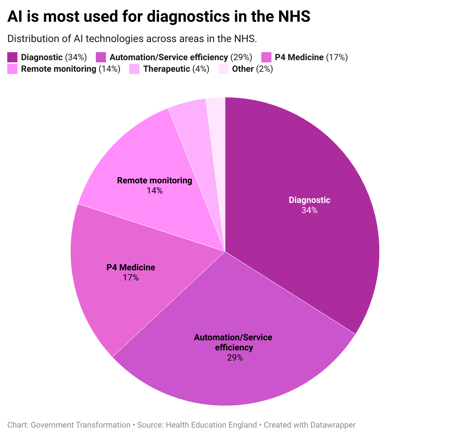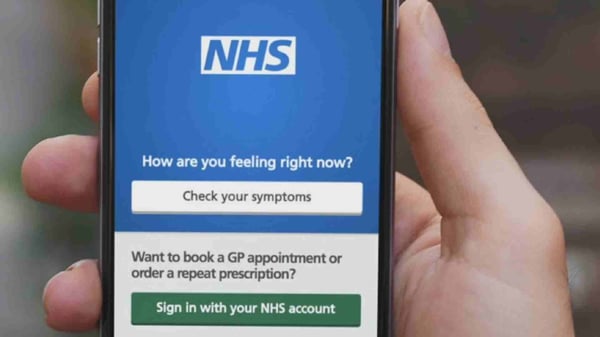AI roadmap to put NHS at the forefront of tech deployment
A landmark roadmap published by Health Education England (HEE) has mapped out NHS use of artificial intelligence (AI) to ensure that healthcare staff have the skills and knowledge to harness the power of the technology and maximise outcomes for patients.
HEE, the public body responsible for NHS skills and training, aims to ensure that healthcare workers are prepared for the emerging technologies described in the 2019 Topol Review.
In September 2021, the NHS Artificial Intelligence Laboratory (NHS AI Lab) published the first draft of the National Strategy for AI in Health and Social Care, setting out its ambitions for the development and adoption of safe, ethical and effective AI-driven technologies across the NHS. This followed updated guidance from the Medicines and Healthcare products Regulatory Agency on the use of AI in healthcare.
 Dr Hatim Abdulhussein, Clinical Lead for the Digital, Artificial Intelligence and Robotics Technologies in Education (DART-Ed) programme at HEE, said that the roadmap is an invaluable asset to understand the AI and data-driven landscape in the NHS and the implications that its deployment has for healthcare staff and learners.
Dr Hatim Abdulhussein, Clinical Lead for the Digital, Artificial Intelligence and Robotics Technologies in Education (DART-Ed) programme at HEE, said that the roadmap is an invaluable asset to understand the AI and data-driven landscape in the NHS and the implications that its deployment has for healthcare staff and learners.
“For us, this piece of work was an opportunity to increase our own understanding of what technologies are out there, which areas they sit within, and what kind of areas of a workforce that they would impact so that we can provision for our own workforce planning,” Abdulhussein told Government Transformation. “But more importantly, [the roadmap ensures] that we have the right upskilling that's needed to work with AI among specific workforce groups so we can understand where we need to target our efforts.”
The paper builds on the objectives of the Topol Review, which outlined a series of recommendations for the implementation of technologies, such as AI, robotics, digital medicine and genomics, with the ambition to make the NHS a world leader in the use of digital technologies for patient care.
Where is AI most used in the NHS?
The roadmap is helping HEE to inform decisions taken with educational providers, Royal Colleges and professional regulators on creating an AI and data-driven workforce.
The report found that diagnostic technologies, such as those used in imaging, pathology and endoscopy, is the most common use of AI in healthcare (34%), followed by automation and service efficiency (29%), P4 medicine (predictive, preventative, personalised and participatory medicine) (17%), remote monitoring (14%), therapeutic (4%), and other uses (2%). This data helps HEE to target their efforts in these areas to make sure that the staff have the right skills and knowledge to work with AI.

“There was quite clearly a need for us to build a workforce capacity in those areas and that's something that we are looking at and have been looking at the NHS AI Lab Transformation Directorate,” said Abdulhussein.
Other key findings of the roadmap include the estimated time of technology deployment and the workforce groups identified as direct users of AI technologies. 'Medic, Clinical Radiology’ staff lead with the use of 15% of technologies, followed by ‘Medic, General Practice’ (13%), ‘Non Clinical, Admin’ (10%), ‘Diagnostic Radiographer’ (8%) and ‘Medic, Cardiology’ (8%). In addition, 77% of AI technologies are used in secondary care, 23% in primary care, and 7% community care.
The authors of the report said these figures show the need for a holistic and cross-organisational strategy to adapt the training provided on the use of AI in the NHS, as well as the need to monitor the spread of AI to ensure fair access to innovative products across regions, points of care and types of sites.
Putting the right infrastructure in place before deploying AI
Reflecting on the AI Roadmap, public sector digital consultant and NED at Hampshire Hospitals NHS Foundation Trust, Jos Creese, said that AI is having a positive impact in many clinical areas within the NHS and has a “massive potential” to transform healthcare in the future.
However, Creese added that AI implementation also presents a challenge for clinicians and health service leaders in areas such as data control, data ethics, bias in information analytics and the need for new risk models for clinical pathways. He also said that it needs to be integrated into wider digital architectures and planning, not just used as ‘point’ solutions in a hospital department.
“To date, most AI applications in health and care settings are used to complement traditional professional care – such as improved and earlier diagnosis of serious conditions,” Creese said. “This will develop, especially in areas such as social prescribing, where AI can begin to unravel the complexity of support needs that can in turn reduce acute service demands – the interplay between related patient need and symptoms.”
Creese thinks that those organisations where digital maturity (rather than ‘IT competency’) is low or data management is traditional and distributed should approach AI with caution. But once the right foundations are in place, AI can solve many of the challenges facing health care today, including productivity, integrated care, effectiveness of specialist interventions, efficiency of delivery, patient-centred design, inclusivity, improved research data and quicker diagnosis and intervention.
“My advice is not to start with the technology, however exciting and appealing,” Creese added. “First, put in place the principles and governance around AI deployment that ensure that the necessary controls, capability, consultation, and safeguards are in place, with a strong understanding of how to maximise and quantify the benefits. Otherwise, we will create a legacy patchwork of proprietary AI projects and hidden risks."
The AI Roadmap was created in collaboration with analytics company Unity Insights, NICE, NHS AI Lab and the NHS Accelerated Access Collaborative (AAC). It is accompanied by an interactive dashboard publicly available showing the areas where AI is being deployed in the NHS.
(Homepage photo by Nicolas J Leclercq on Unsplash.)





